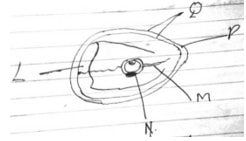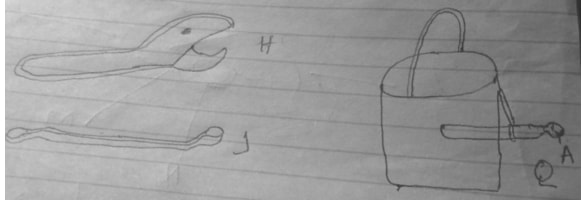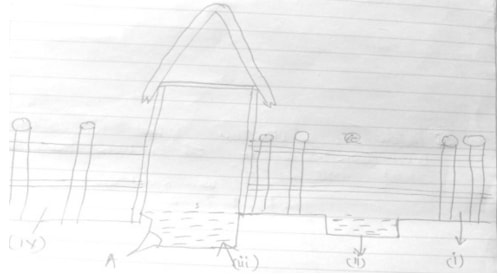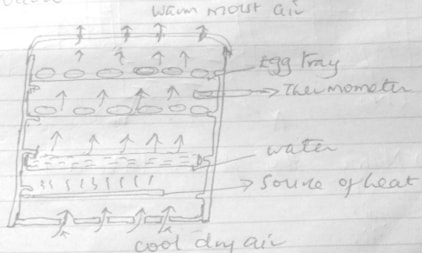SECTION A
Answer all questions in this section
- State four mechanical methods of controlling ticks. (4mks)
- Give two examples of feed addicted in cattle. (1mk)
- Name the mineral deficiently that causes each of the following condition in livestock.
- Grass stagger (Tetany) (½mk)
- Milk fever/parturient parensis (½mk)
- Name two hormones produced in a lactating cow. (2mks)
-
- What is referred to as a ‘Notifiable disease’ (1mk)
- Name four examples of notifiable diseases in livestock. (2mks)
- Outline three pre-disposing factors of footrot disease in sheep. (1 ½mks)
- List any four metal work tools and equipment used in the farm. (2mks)
- Outline four qualities of eggs for incubation. (2mks)
- State four prophylactic measures used by a farmer to control livestock diseases. (2mks)
- Give three methods of feeding colostrums to newly born calves. (1 ½ mks)
-
- Define the term “zoonote disease.” (1mk)
- Give two examples of zoonote diseases. (1mk)
- List three advantages of hedges. (1 ½ mks)
- Why is it necessary to provide grit to birds? (1mk)
- State four good qualities of honey. (2mks)
- State two causes of soft shell in eggs. (1mk)
- Name three methods of livestock selection. (1 ½ mks)
- Name a tool used for tightening barbed wires during fencing. (1mk)
SECTION B.
Answer all the questions in this section
- Study the diagram of an egg below and answer the question that follow.

- Name the parts labeled N,Q and P. (1 ½ mks)
- State the function of the parts labeled M and L. (1 ½mks)
- Why should the egg be turned during incubation. (1mk)
- State four reasons of treating timber. (4mks)
- Below are the diagrams of workshop tools H, J and Q. Study them and answer the question that follow.

- Identify each tool. (1 ½ mks)
H_________
J__________
Q_________ - What functional advantages does H have over J. (1mk)
- Why is the part labeled H an important component of watering can. (1mk)
- Identify each tool. (1 ½ mks)
- Below is a diagram of a certain farm structure. Use it to answer the questions that follow.

- Name the parts labelled (i), (ii), (iii), (iv)
- Identify the part labeled A. (½ mk)
- Give the function of the part labeled A. (½ mk)
- State two maintenance practice carried out in part (ii) above. (2mks)
- Below is a structure used in poultry production. Use it to answer the questions that follow.

- Identify the structure. (1mk)
- State the main function of the structure. (1mk)
- Give the function of the following in the structure.
Water (½mk)
Thermometer (½mk)
SECTION C
Answer any two questions in this section.
-
- Outline the use of fence in the farm. (10mks)
- Discuss the tractor transmission system. (10mks)
-
- Discuss foot and mouth disease under the following sub-headings.
- Animal affected. (2mks)
- Methods of transmission. (2mks)
- Symptoms of attack. (4mks)
- Control measures. (2mks)
- Outline general control measures of livestock parasites. (10mks)
- Discuss foot and mouth disease under the following sub-headings.
-
- Outline the various methods of maintaining farm tools and equipment. (8mks)
- Describe artificial rearing of layer chicks from day one to end of brooding. (12mks)
MARKING SCHEME
-
- Rotational grazing
- Hand picking / deticking and killing
- Hand dressing
- Burning pastures / paddocks
- Double perimeter fencing (1x4) 4mks
-
- Hormones e.g. stilbestrol
- Antibiotics e.g. tetranyne
Reg collidiostat medicants 2 x ½ = 1m
-
- Grass tetany – Lack of magnesium ions (mg2+)
- Milk fever - Lack of calcium ions (Ca2+) (½mk)
-
- Oxytocin
- Andrenaline (2 x 1/2 = 1mk)
-
- A disease that is highly contagious and infectious and needs notification of the relevant authorities to impose quarantine for its control. (1mk)
-
- Rinderpest (cattle plague)
- Anthrax
- New castle
- Foot and mouth disease
- Rift valley fever (4 x ½ = 2mks)
-
- Filthy sorroundings e.g. wet and muddy areas
- Sharp objects
- Overgrown hooves (3 x ½) = 1 ½ mks)
-
- Soldering gun
- Tins ship
- Centre punch
- Hacksaw (4 x ½ ) = 2mks
-
- Smooth shell
- Medium size
- Clean
- Free from abdomalities e.g. blood spot, meat spot, double yolk
- Free from crack
- Fertile egg (4 x ½ = 2mks
-
- Vector control
- Isolating sick animals
- Vaccination
- Use of prophylactic drugs (4 x ½ = 2mks)
-
- Natural rearing
- Foster rearing
- Artificial rearing / bucket feeding (3 x ½ = 1 ½ mks)
-
- Are those that are transmitted from animal to a man or from man to animal. (1mk)
- Anthrax, Brucellosis, Rabies, Tuberculosis, Rift valley fever, Trichomomasis, mud cow disease (2 x ½ = 1mk)
-
- Provide shade to livestock.
- Cheap and easy to establish
- Tall varieties act as wind breakers e.g. kai apple
- Have aesthetic value/beauty
- Roots hold soil firmly controlling soil erosion
- Can be used as a livestock feed. (3 x ½ = 1½ mks)
- To aid in grinding grains into paste by thick muscle of the gizzard. (1mk)
-
- Purity - free from wax, wings / smoke, combs
- Colour - Brown yellow
- Viscosity - Not dilute or too thick
- Smell - Right smell not of rotten combs (4 x ½ mks) = 2mks
-
- Lack of calcium
- Effects of some diseases e.g. New castle
-
- Mass selection
- Progeny testing
- Contemporary comparison (3 x ½ = 1½ mks)
- Monkey strainer / wire strainer (1x1 = 1mk)
-
- N - Yolk
Q - Shell membrane
P - Egg shell (3 x ½ = 2mks) - M - Holds the yolk in position (central position)
L - Air space (supplies air to the developing chick) (2 x 1 = 2mks - Prevent germinal disc from sticking on the side
Ensure enough ventilation to all parts. (1 x 1 = 1mk)
- N - Yolk
-
- To prevent warping/bending or twisting
- To prevent rotting/damage by fungi
- To protect it from pest attack
- To make timber achieve its maximum strength (4 x 1 = 4mks)
-
- H - Adjustable spanner
J - Ring spanner
Q - Watering can (3 x ½ = 1½ mks - - Adjustable spanner can be used for tightening / loosening different sizes of nuts while ring spanner can be used to tighten or loosen at least two different sizes of nuts. (1 x 1 = 1mk)
- Causes water to come out in spreading manner hence reducing its impact on seedlings while at the same time avoiding soil erosion. (1 x 1 = 1mk).
- H - Adjustable spanner
-
-
- Entrance / yard
- Foot bath
- Dip tank
- Drainage race (4 x ½ = 2mks)
- Exist steps / stairs / lead out stairs. 1 x ½ = ½ mk
- part A allows animals to come out of the dip wash / dip tank (1 x ½ = ½ mk)
-
- Cleaning / removing mud or dung
- Changing water when dirty
- Adding more disinfectant (2 x 1 = 2mks
-
-
- Artificial incubator (1mk)
- Provide fertilized eggs with suitable conditions for embryoric development (1mk)
-
- Water - Gives required relative humidity (½mk)
- Thermometer - Determines actual temperature in the incubator (½ mk)
SECTION C
-
-
- Keep off animals / domestic animals
- Add aesthetic value
- Add value to the farm
- May provide livestock feeds, fuel and human food
- Help control pests and diseases
- Some act as wind breaks
- Control breeding
- Control grazing by use of paddocks
- Marking boundaries
- Keep off intruders / thieves (1x10 = 10mks)
-
-
- Disconnects engine from lest of power transmission system.
- Interrupts power flow engine, allowing selection of one gear to another.
- Alters relation between engine speed and wheel speed.
- Allows one wheel to move faster than the other e.g. corner negotiation, speed reduction mechanism.
- Rotates wheels and transmits power from differential to final drive.
- Reduces speed of revolutions for low speed to reach the wheel.
- Wheel rotates allowing tractor movement, order should be maintained (5x2 = 10mks)
(Award explanation if identity / structure is correct.
-
-
-
-
- Cattle, sheep, goats, pigs (2 x 1 = 2mks)
-
- Ingestion of contaminated water / feed with saliva blood.
- Machinery and animals / human from one form to another. (2 x 1 = 2mks)
-
- Rapid rise in temperature
- Painful blisters in muzzle, udder and mouth
- Lack of appetite – difficult eating
- Excessive salivation
- Lameness and peeling hooves
- Grinding teeth
- Dullness and shivering 4 x 1 = 4mks
-
- Quarantine
- Report to government authorities
- Compulsory vaccination
- Treat the wounds (2 x 1 = 2mks)
-
- Rotational grazing / paddocking
- Regular deworming
- Spraying / dipping in acaricide
- Maintaining hygiene / proper sanitation
- Double fencing
- Proper meat inspection
- Proper cooking of meat
- Proper disposal of human waste / proper use of latrines.
- Draining of marshy areas / fencing off marshy areas
- Burning infested pastures during dry season
- Ploughing infested pastures
- Hand picking / physical killing
- Biological control / sterilizing male tsetseflies
- Applying chemicals to kill parasites and intermediate hosts e.g. copper sulphate to kill water snails in marshy areas. 10 x 1 = 10mks
-
-
-
- Use the right tools for the right work
- Handle tools and equipment properly
- Clean tools after use
- Store tools at the right places
- Replace and repair worn out parts of the tools
- Grease moving parts and bearings
- Sharpen cutting edges / digging edges of the tools
- Oil exposed parts to prevent rusting
- Straighten bent blades
- Tighten loose nuts and bolts (8 x 1 = 8mks)
-
- Ensure brooder corners are rounded.
- Provide enough brooding space
- Clean and disinfect brooder and equipment
- Provide proper guard around heat source
- Provide proper litter on floor / wood shavings
- Maintain appropriate temperature according to age of the chick
- Temperature during first week 32 – 350C, then reduce accordingly.
- Maintain proper ventilation by adjusting openings.
- Provide adequate fresh quality feeds / chick mash
- Provide dim light in the brooder
- Remove dead chicks
- Provide adequate and appropriate waterers
- Control parasites by applying appropriate pesticides
- Control diseases using appropriate method e.g. vaccination.
- Treat sick chicks
- Provide adequate water
- Keep proper records
- Debeak 8 – 10 days towards end of brooding
- Gradual change of chick mash to growers mash during last one week
- Spread newspapers on top of litter for the first few days and scatter feed on them
- Isolate the sick chicks (12x 1 = 12mks
-
Join our whatsapp group for latest updates
Tap Here to Download for 50/-
Get on WhatsApp for 50/-
Download AGRICULTURE PAPER 2 - FORM 4 END TERM 1 EXAMS 2020.
Tap Here to Download for 50/-
Get on WhatsApp for 50/-
Why download?
- ✔ To read offline at any time.
- ✔ To Print at your convenience
- ✔ Share Easily with Friends / Students

